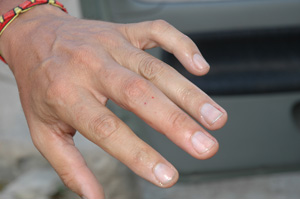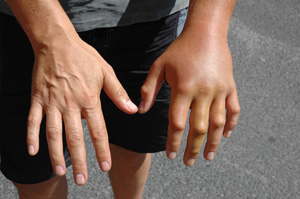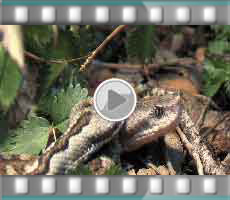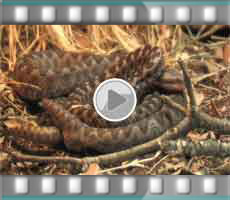LATASTE´S VIPER (Page 2)
Reproduction:
Some weeks after the hibernation period is over the vipers get involved in an intense courtship in which the males try eagerly to copulate with the females.
Copulations normally take place between the end of April and the end of May. Gravid females go through a gestation of three months, which may be a bit longer for the Vipera latastei gaditana subspecies.
By the end of August three to twelve baby vipers are born in a labour that lasts between two and three hours. Newborn vipers shed their skin right after birth. The reproductive cycle takes place every second year, while in the cooler regions it may even be triennial.
Venom: A bite from Vipera latastei is normally not life threatening for a human being, except in the cases of elderly people, children or unhealthy persons. However, a bite should always be monitored by a doctor and treated in a hospital. The Lataste´s viper´s venom toxicity is relatively low when compared to that of the other Iberian vipers (Vipera aspis and Vipera seoanei). The nominate form of the Lataste´s viper (Vipera latastei latastei) reaches a LD50* of around 20 mg, while the southern form (Vipera latastei gaditana) reaches a LD50 of 29 mg, which makes it the least toxic venom of all the Iberian vipers. Nevertheless, the Lataste´s viper is capable of inoculating a larger quantity of venom than the other two Iberian species (Vipera aspis and Vipera seoanei), being that the reason why their bites are equally dangerous.

Vipera latastei bite
Note both puncture marks on the middle finger
Note both puncture marks on the middle finger

Vipera latastei bite, one day later
* DL50 (Lethal Dose 50% or median lethal dose) is the dose required to kill half the members of a tested population (laboratory mice) after a specified test duration. Expressed in milligrams, it indicates the degree of toxicity of a venom; lower values of LD50 indicate a higher toxicity.
Subspecies:
Currently there are two subspecies widely accepted; the nominate form Vipera latastei latastei and the subspecies Vipera latastei gaditana. Specimens from the northwestern regions of the Iberian Peninsula show significant morphological variations that could separate them from the nominate form at a subspecific level. Something similar occurs with the population found in the northern versant of the Gredos mountain range (see article: Vipera latastei abulensis). In any case, Vipera latastei is a highly variable species and the differentiation and classification of subspecies tends to be controversial.


